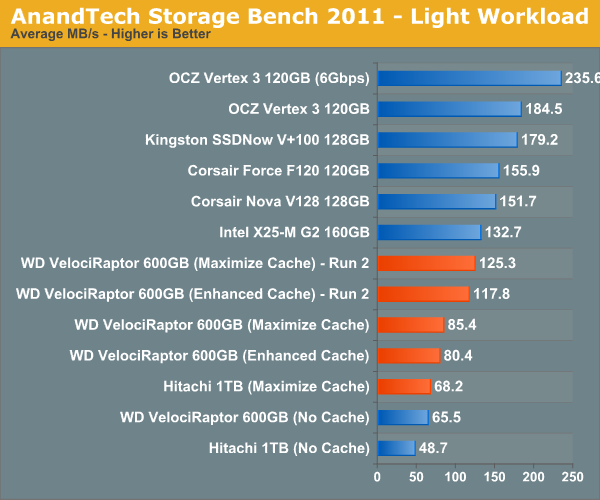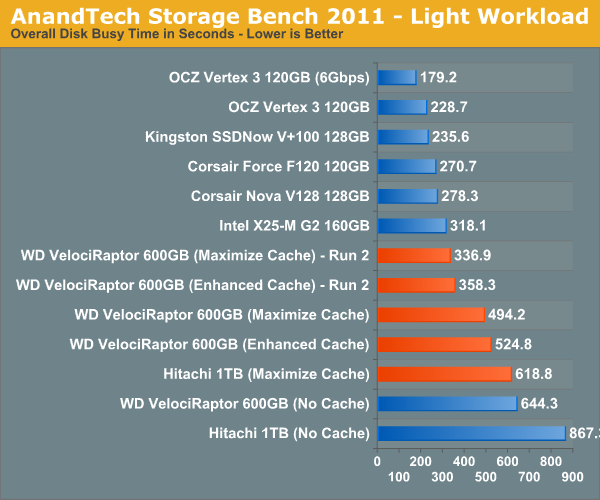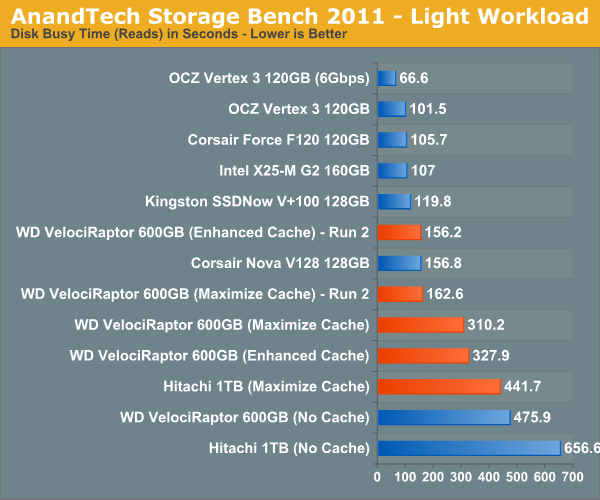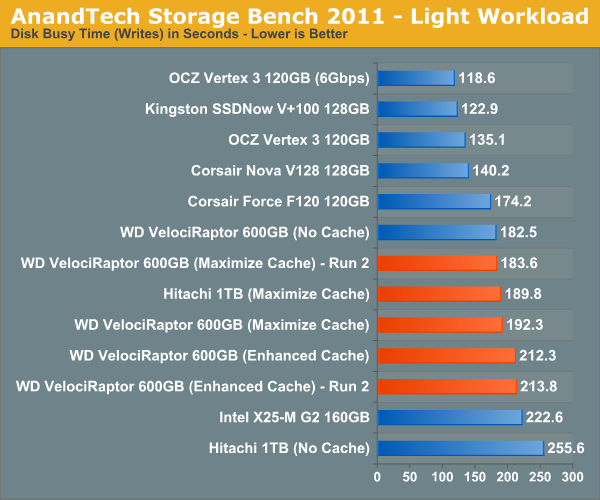Intel Z68 Chipset & Smart Response Technology (SSD Caching) Review
by Anand Lal Shimpi on May 11, 2011 2:34 AM ESTAnandTech Storage Bench 2011—Light Workload
Our new light workload actually has more write operations than read operations. The split is as follows: 372,630 reads and 459,709 writes. The relatively close read/write ratio does better mimic a typical light workload (although even lighter workloads would be far more read centric).
The I/O breakdown is similar to the heavy workload at small IOs, however you'll notice that there are far fewer large IO transfers:
| AnandTech Storage Bench 2011—Light Workload IO Breakdown | ||||
| IO Size | % of Total | |||
| 4KB | 27% | |||
| 16KB | 8% | |||
| 32KB | 6% | |||
| 64KB | 5% | |||
Despite the reduction in large IOs, over 60% of all operations are perfectly sequential. Average queue depth is a lighter 2.2029 IOs.

While the heavy workload was long enough to not show any benefit in performance by running it multiple times, our light workload boasts serious gains if we run it a second time with the cache active. With a light enough workload the SSD 311 as a cache can actually bring hard drive performance up to the level of an Intel X25-M G2, which is exactly what Intel was targeting with Smart Response Technology to begin with. For light users you can get an SSD-like experience at a fraction of the cost and without having to manage data across two drives.















106 Comments
View All Comments
jordanclock - Wednesday, May 11, 2011 - link
You can use a drive for both, but you must set up your data partition AFTER you set up the cache partition.jorkolino - Wednesday, June 6, 2012 - link
What do you mean by that? You partition the SSD drive, install the OS in the first partition, set-up the other partition as a cache, and then format your remaining HDD?jorkolino - Wednesday, June 6, 2012 - link
I wonder, can you tell SRT to cache blocks only from the HDD onto the cache partition, because by default SRT may decide to cache system files that already reside onto a fast SSD partition...evilspoons - Wednesday, May 11, 2011 - link
I know it's early on for Z68, but I'm curious how other SSDs will perform in SRT mode. I ask because the 40 GB X25-V is on sale here for half its usual price...evilspoons - Wednesday, May 11, 2011 - link
To answer my own question, Tom's Hardware reviewed SRT with several SSDs and to put it bluntly, the X25-V sucks. Its very low write speed of 35 mb/sec actually drags the hard drive down in a few tests.Shadowmaster625 - Wednesday, May 11, 2011 - link
Yeah that is a nice way of putting it. Talk about sugar coating. Here is a question for ya: was intel being "conservative" when they tried to shove rambus down everyone's throats? If it werent for AMD and DDR god knows how much memory would cost now. I still have one of those rambus P4 systems running in the lab right now. (intel 850 chipset with dual channel RDRAM). I did some memory benchmarking on it and was shocked to find that it was actually slower than any of the P4 DDR 266 machines we have running. (Yes we are slow to upgrade lol.) It runs at about DDR200 equivalent speeds. And we really paid out the wazoo for that system.Shinobisan - Wednesday, May 11, 2011 - link
discrete graphics cards are limited - even though they often have three, four.. or more connectors these days, they can often only drive two monitors at a time. (unless you use a displayport connector... and monitors with DP don't really exist yet)I have two monitors driven by my HD6950 via the digital video out connectors. So the HDMI connector on that card is "dead" until I turn one of the monitors off.
What I would like to be able to do... is have my dGPU drive my two monitors, and the iGPU drive my 1080p TV via HDMI.
Can I do that? This discussion on virtu muddies the water some. unclear.
Conficio - Wednesday, May 11, 2011 - link
Well, so SRT is a good idea but again it is limited artificially in its use. Sounds to me like the P67/H67 stund all over again.Why is it limited?
* For starters it is driver supported, and I believe that means Windows only (I could find no mention of what OS is supported). To be fully useful it belongs into the chipset/BIOS realm.
* Next there is the artificial 64GB limit. As is obvious from even the tests that is not really the practical limit of its usefulness. It is simply a marketing limit to not compete with Intels own full SSD business. You got to ask yourself, why not use your aging SSD of 100GB or 256 GB (a couple years down the road) as an SRT drive?
* "With the Z68 SATA controllers set to RAID (SRT won't work in AHCI or IDE modes) just install Windows 7 on your hard drive like you normally would." So only RAID setups are supported? Well you are testing with a single hard drive, so this might be a confusing statement. But if it is RAID only then that is ceratinly not what Joe Shmoe has in its desktop (let alone in its Laptop).
A5 - Wednesday, May 11, 2011 - link
If the AT Heavy Workload Storage Bench is a typical usage case for you, than you shouldn't be using SRT anyway - you'd have a RAID array of SSDs to maximize your performance.jordanclock - Wednesday, May 11, 2011 - link
For caching purposes, I'm sure 64GB is a very reasonable limit. The more data you cache, the more data you have to pay attention to when it comes to kicking out old data.And it isn't a RAID set up, per se. You set the motherboard to RAID, but the entire system is handled in software. So Joe Shmoe wouldn't even have to know what a RAID is, though I don't see Joe Shmoe even knowing what a SSD is...